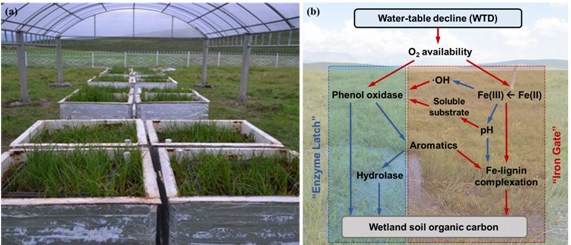Wetlands, covering 5–8% of the Earth’s land surfaces, store up to 535 Gt of carbon below ground, representing approximately 30% of global terrestrial carbon pool. However, under climate and land-use changes, about half of the global wetland area has been lost due to water-table decline (WTD). Improved drainage during WTD or drought may turn wetlands from carbon sinks to sources through increasing decomposition, causing major concern for carbon sequestration and climate mitigation procedures. Nevertheless, the response of wetland soil organic carbon (SOC) to WTD remains highly uncertain.
Dr. Xiaojuan FENG’s group at the Institute of Botany, Chinese Academy of Sciences (CAS) examined the under-investigated role of iron (Fe) in mediating soil enzyme activity and lignin stabilization in a mesocosm WTD experiment in an alpine wetland. In contrast to the classic “enzyme latch” theory, phenol oxidative activity is mainly controlled by ferrous iron [Fe(II)] and declines with WTD, leading to an accumulation of dissolvable aromatics and a reduced activity of hydrolytic enzyme. Furthermore, by removing Fe oxides, they observed a significant increase of Fe-protected lignin phenols in the air-exposed soils. Fe oxidation hence acts as an “iron gate” against the “enzyme latch” in regulating wetland SOC dynamics under oxygen exposure. This newly-recognized mechanism may be key to predicting wetland soil carbon storage with intensified WTD in a changing climate.
These results have recently been published online in Nature Communications. Yiyun WANG, a Ph.D. student of Feng’s group is the first author of the paper and Dr. Xiaojuan Feng is the corresponding author. This work was supported the Chinese National Key Development Program for Basic Research and the National Natural Science Foundation of China.

Figure: (a) The mesocosm water-table decline experiment at the Haibei Research Station, Qinghai Province, China; (b) Conceptual model showing the “iron gate” versus “enzyme latch” mechanisms influencing wetland soil organic carbon during water-table decline.
Publication link:
https://www.nature.com/articles/ncomms15972
CONTACT INFO:
Feng Xiaojuan
State Key Laboratory of Vegetation & Environmental Change
Institute of Botany,
Chinese Academy of Sciences,
20 Nanxincun, Xiangshan, Beijing 100093, China
E-mail: xfeng@ibcas.ac.cn
Wetlands, covering 5–8% of the Earth’s land surfaces, store up to 535 Gt of carbon below ground, representing approximately 30% of global terrestrial carbon pool. However, under climate and land-use changes, about half of the global wetland area has been lost due to water-table decline (WTD). Improved drainage during WTD or drought may turn wetlands from carbon sinks to sources through increasing decomposition, causing major concern for carbon sequestration and climate mitigation procedures. Nevertheless, the response of wetland soil organic carbon (SOC) to WTD remains highly uncertain.
Dr. Xiaojuan FENG’s group at the Institute of Botany, Chinese Academy of Sciences (CAS) examined the under-investigated role of iron (Fe) in mediating soil enzyme activity and lignin stabilization in a mesocosm WTD experiment in an alpine wetland. In contrast to the classic “enzyme latch” theory, phenol oxidative activity is mainly controlled by ferrous iron [Fe(II)] and declines with WTD, leading to an accumulation of dissolvable aromatics and a reduced activity of hydrolytic enzyme. Furthermore, by removing Fe oxides, they observed a significant increase of Fe-protected lignin phenols in the air-exposed soils. Fe oxidation hence acts as an “iron gate” against the “enzyme latch” in regulating wetland SOC dynamics under oxygen exposure. This newly-recognized mechanism may be key to predicting wetland soil carbon storage with intensified WTD in a changing climate.
These results have recently been published online in Nature Communications. Yiyun WANG, a Ph.D. student of Feng’s group is the first author of the paper and Dr. Xiaojuan Feng is the corresponding author. This work was supported the Chinese National Key Development Program for Basic Research and the National Natural Science Foundation of China.

Figure: (a) The mesocosm water-table decline experiment at the Haibei Research Station, Qinghai Province, China; (b) Conceptual model showing the “iron gate” versus “enzyme latch” mechanisms influencing wetland soil organic carbon during water-table decline.
Publication link:
https://www.nature.com/articles/ncomms15972
CONTACT INFO:
Feng Xiaojuan
State Key Laboratory of Vegetation & Environmental Change
Institute of Botany,
Chinese Academy of Sciences,
20 Nanxincun, Xiangshan, Beijing 100093, China
E-mail: xfeng@ibcas.ac.cn
